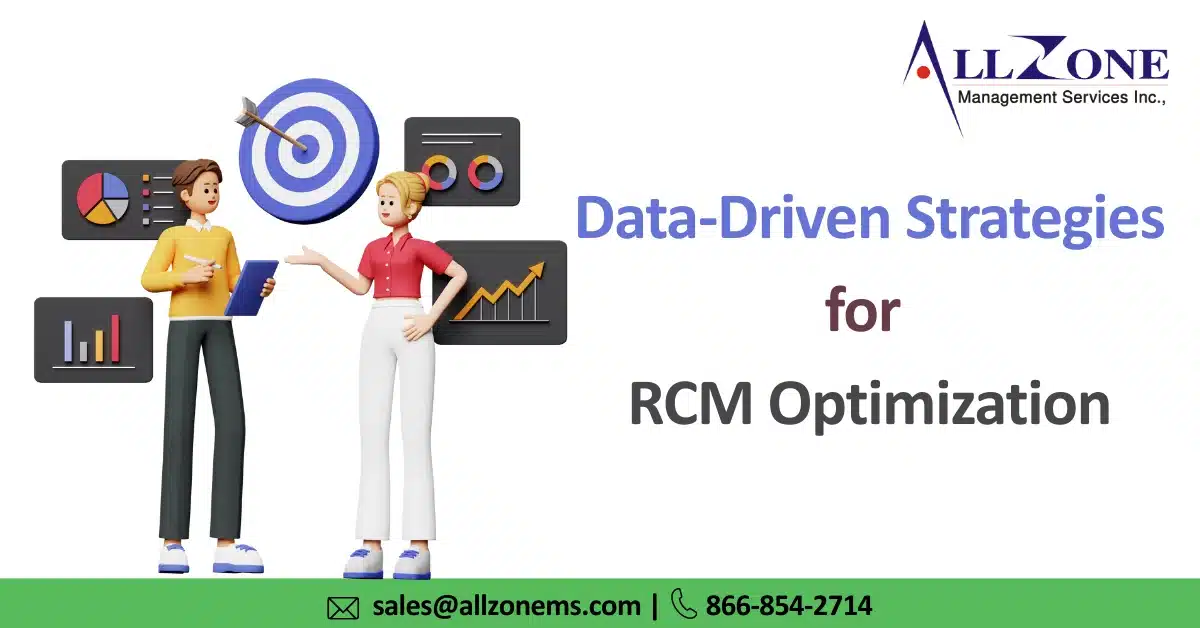RCM optimization: While maximizing revenue is paramount in today’s competitive business environment, many organizations experience inefficiencies in their RCM processes. Here’s where data becomes your secret weapon. With data-driven strategies, you can maximize your revenue cycle management (RCM), unlock revenue potential, and grow significantly.
Understanding RCM and its Impact on Revenue
In Revenue Cycle Management (RCM), all the steps involved in converting a sale into cash are included. A well-oiled RCM system ensures a smooth flow of revenue and minimizes financial leakages. It includes activities such as order processing, billing, claims submission, payment collection, and denial management.
The following are some of the possible consequences of a disjointed RCM:
-
- The potential for revenue loss is increased when unidentified or unbilled charges are not identified, claims are delayed, and collections are inefficient.
- Operational costs have increased due to manual processes, rework due to errors, and penalties for late filings.
- An uncollected receivable backlog and delayed payments lead to negative cash flows.
- Insufficient billing accuracy, slow collections, and a complex payment process can result in reduced customer satisfaction.
The Fuel for RCM Optimization
A successful revenue cycle management optimization strategy relies on the analysis of data. Your organization generates a wealth of information through various touch points in the revenue cycle. This information provides you with valuable insights into customer behavior, billing patterns, payment trends, and areas that can be improved.
Here’s how data empowers RCM optimization:
-
- Revenue Leakage Detection: Data analysis can reveal where revenue is slipping through the cracks. These could be unbilled services, incorrect billing codes, and missed billings.
- Streamlining Workflows: By analyzing historical data and current processes, you can identify bottlenecks and redundancies. This can aid in automating tasks, improving claim submission accuracy, and speeding up collection efforts.
- Customer Behavior Data: Customer behavior data can help predict payment patterns and identify high-risk accounts, which allows proactive collection strategies and targeted interventions.
- Engage your customers: Use data insights to customize billing statements and communication to their needs. Personalized communication improves customer engagement and on-time payments.
- Decisions driven by data: Data allows you to make informed decisions about resource allocations, pricing strategies, and collection efforts.
Unlocking Growth through Data-Driven RCM Strategies
Here are some key data-driven strategies to optimize your RCM and unlock revenue growth:
1. Data Cleansing and Standardization:
Clean and standardized data is the foundation of any data-driven strategy. Make sure all data points are formatted consistently within your RCM system, addressing errors and inconsistencies to avoid inaccurate reporting.
2. Leveraging Analytics and Reporting:
To turn raw data into actionable insights, invest in robust analytics tools. Generate reports that track key performance indicators (KPIs) such as Medical billing accuracy, collection rates, denial rates, and days in arrears. It is important to regularly report on your optimization efforts so you can monitor progress, identify trends, and measure their effectiveness.
3. Customer Segmentation:
The data-driven approach allows you to tailor billing processes, payment options, and collection strategies to specific customer segments based on their payment behavior, service utilization, and industry. In the case of high-risk accounts, frequent follow-up might be necessary, whereas customers with low-risk accounts can benefit from self-service payment options.
4. Automating Workflows:
By automating repetitive tasks, such as submitting claims, reminding clients to make payments, and entering data, valuable staff time will be freed up to focus on more strategic activities, such as resolving complex issues and focusing on high-value accounts.
5. Proactive Denial Management:
To minimize denials, analyze historical claim denial data to identify patterns and root causes. Reduce revenue loss and streamline the claim reimbursement process with proactive denial management by submitting accurate claims with complete documentation from the outset.
6. Enhancing Customer Communication:
Detailed billing statements with charges and payment options should be provided to customers. Providing multiple payment options and proactive communication improves customer satisfaction and encourages timely payments. Online portals, mobile payments, and automated payment plans are convenient payment options.
7. Machine Learning for Predictive Analytics:
In addition to predicting customer payment behavior, advanced analytics tools utilizing machine learning can be used to identify potential delinquencies as early as possible, and to implement targeted interventions to prevent them.
Embrace the Data-Driven Future of RCM
In today’s healthcare environment, RCM services must go beyond traditional billing and collections. RCM companies that leverage data strategically can transform the entire Revenue Cycle Management (RCM) process into a powerful revenue engine instead of a cost center.
In data-driven RCM optimization, actionable insights, streamlined Revenue Cycle Management processes, and improved efficiencies are the key. It’s not just about collecting data—it’s about using it intelligently. By doing so, organizations will see revenue increase, costs decrease, cash flow improve, and overall financial performance strengthen.
Partnering with forward-thinking RCM companies ensures your practice or healthcare organization can fully unlock the potential of RCM services through strategic data use, driving measurable growth and operational excellence.

